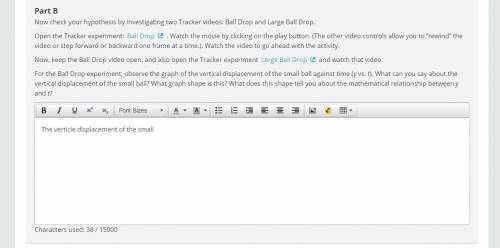
Physics, 02.09.2021 21:50 djennings8055
Now check your hypothesis by investigating two Tracker videos: Ball Drop and Large Ball Drop.
Open the Tracker Ball Drop . Watch the movie by clicking on the play button. (The other video controls allow you to “rewind” the video or step forward or backward one frame at a time.). Watch the video to go ahead with the activity.
Now, keep the Ball Drop video open, and also open the Tracker Large Ball Drop and watch that video.
For the Ball Drop experiment, observe the graph of the vertical displacement of the small ball against time (y vs. t). What can you say about the vertical displacement of the small ball? What graph shape is this? What does this shape tell you about the mathematical relationship between y and t?
Small ball dropper experiment:http://contentstore. ple. platoweb. com/content/sharedmedia/Tracker/app lications/ball-drop-1/ball-drop-1.h tml
Large ball dropper experimenthttp://contentstore. ple. platoweb. com/content/sharedmedia/Tracker/app lications/ball-drop-large/ball-drop -large. html


Answers: 2


Other questions on the subject: Physics

Physics, 21.06.2019 22:30, mirellaenriquez5529
Follow these directions and answer the questions. 1. shine a pencil-thin beam of light on a mirror perpendicular to its surface. (if you don't have a laser light as suggested in the video, you can make a narrow beam from a flashlight by making a cone from black construction paper and taping it over the face of the flashlight.) how does the light reflect? how does the relationship of incident to reflected ray relate to the reflection of water waves moving perpendicular to a barrier? 2. shine a pencil-thin beam of light on a mirror standing on a sheet of paper on the table (or floor) so that you can mark the incident ray and reflected ray. (you can support the mirror from the back by taping it to a wooden block.) 3. mark a line on the paper representing the reflective surface. (the reflective surface of a mirror is usually the back edge.) 4. draw a dashed line perpendicular to the mirror surface at a point where the incident and reflected ray meet. this perpendicular is called a normal to the surface. 5. measure the angles between the rays and the normal. the angle of incidence is the angle formed by the incident ray and the normal to the surface. the angle formed by the reflected ray and normal is called the angle of reflection (r). what is the angle of incidence? what is the angle of reflection? 6. repeat for several different angles. (see report sheet for details.) what appears to be the relationship between the angle of incidence and angle of reflection? in science 1204, what was the relationship for these two angles made by the reflection of waves in a ripple tank? 7. roll a ball bearing so that it hits a fixed, hard surface (a metal plate) at several angles (including head-on). observe the way in which the ball bearing reflects. what generalization can you make about how a ball bearing reflects from a wall? have you proved that light can only behave like a wave?
Answers: 1

Physics, 22.06.2019 15:50, janeou17xn
Decreased sensitivity to an unchanging stimulus is known as
Answers: 3


Physics, 22.06.2019 20:30, cnicole71
Ascientist notices that an oil slick floating on water when viewed from above has many different colors reflecting off the surface, making it look rainbow-like (an effect known as iridescence). she aims a spectrometer at a particular spot and measures the wavelength to be 750 nm (in air). the index of refraction of water is 1.3
Answers: 1
You know the right answer?
Now check your hypothesis by investigating two Tracker videos: Ball Drop and Large Ball Drop.
Open...
Questions in other subjects:





History, 06.12.2020 19:50


Mathematics, 06.12.2020 19:50

Mathematics, 06.12.2020 19:50


Biology, 06.12.2020 19:50



